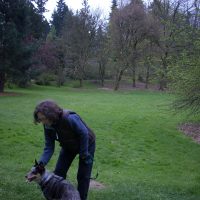Volunteer Spotlight: Kirsten Rasmussen

Kirsten is a Volunteer at the Elisabeth C. Miller Library. She grew up in Denmark near Copenhagen and relocated to the Seattle area in October of 2011. Kirsten likes to garden, knit, and sing in her free time.
She has a BS in biochemistry and biology and a BS in library and information science. Her favorite classes in college were evolution and classification of higher plants, native plant identification, and information retrieval.
Chicken Keeping at the UW Farm with Mallory Culbertson
As part of her UW senior capstone project, student farmer Mallory Culbertson has been working hard to bring chickens to the UW Farm! We hope to have a flock of feathered friends in 2017 but in the meantime, check out this informative Chicken Keeping Handbook Mallory created for other student farmers.
If you’d like to learn more, you can view her project’s annotated bibliography HERE.
Tour Spring Ephemerals at the Miller Garden
Join us on April 7 at the Elisabeth C. Miller Botanical Garden for a tour of the lovely spring ephemerals.
Read moreStudent Spotlight: Daniel Sorensen

Daniel Sorensen is a graduate student at the UW School of Environmental and Forest Sciences, working in the lab of UW Botanic Gardens Director, Sarah Reichard, and researching the risk of invasion across Washington and Oregon of 2 two closely related grasses in the genus Cortaderia – pampas grass and jubata grass. Daniel works as the Integrated Pest Management (IPM) and Sustainability Coordinator for UW Grounds Management, and in that role he helps manage invasive species in the Union Bay Natural Area along with UW Botanic Gardens staff.
Read moreInternships at SkyRoot Farm!
SkyRoot Farm has been approved by the State of Washington to host (2) official farm interns on our farm this summer! SkyRoot is an integrated vegetable farm located on Whidbey Island in the Puget Sound. The 20 acre farm is an active site of restoration agriculture – a form of agriculture that works to restore both ecological function as well as food production to a farm system.
Read moreBoraginaceae; the family that makes little blue flowers
Blooming now in the arboretum are several large arrays of blue flowered ground covers in the Borage family. They make a stunning effect, especially if you adore carpets of little blue flowers as I do.
There are 146 genera in this family with roughly 2000 species including garden favorites such as Star Flower, Borage, and Forget-Me-Nots, Myosotis, which are annuals and can be grown in the sun.
Staff Spotlight: Rebecca Alexander

Rebecca Alexander is the Plant Answer Line librarian in the Elisabeth C. Miller Library. In addition to providing reference services, she works on acquisitions, cataloging, and a wide assortment of tasks including editing Miller Library and other publications, and updating the library’s database of questions and answers.
Rebecca grew up in Seattle and spent some of her early childhood years living near the current site of the Douglas greenhouses at the Center for Urban Horticulture.
Introducing: Our New Chicken Coop!
The sweetest little teardrop trailer you ever saw!
Lovely work by Saltbox Designs. Stay tuned for more pictures as we continue working to bring chickens to the UW Farm!
Glimpse into the past – The UW Plant Laboratory Complex
By John A. Wott, Director Emeritus
The Center for Urban Horticulture officially began in 1980 with the arrival of Dr. Harold B. Tukey as the founding Director. He was given an office in the northeast corner (first floor) of Winkenwerder Hall in the College of Forestry Dean’s complex. His administrative assistant, Sally Dickman, was nearby.
When the first two new faculty arrived in 1981– John A.
February Color Appears at the Washington Park Arboretum (Part II)
1) Chaenomeles cathayensis Chinese Quince
This deciduous shrub is native to slopes and forest margins in western Hubei Province.
Light pink flowers in spring are followed by large oblong fruit which are unpalatable raw, but make fragrant jams and jellies when cooked.
Like other quince, Chaenomeles cathayensis’ arching branches are armed with stiff thorns.
Two specimens can be seen in the old field nursery south of the Crab Apple Meadow near Arboretum Drive.